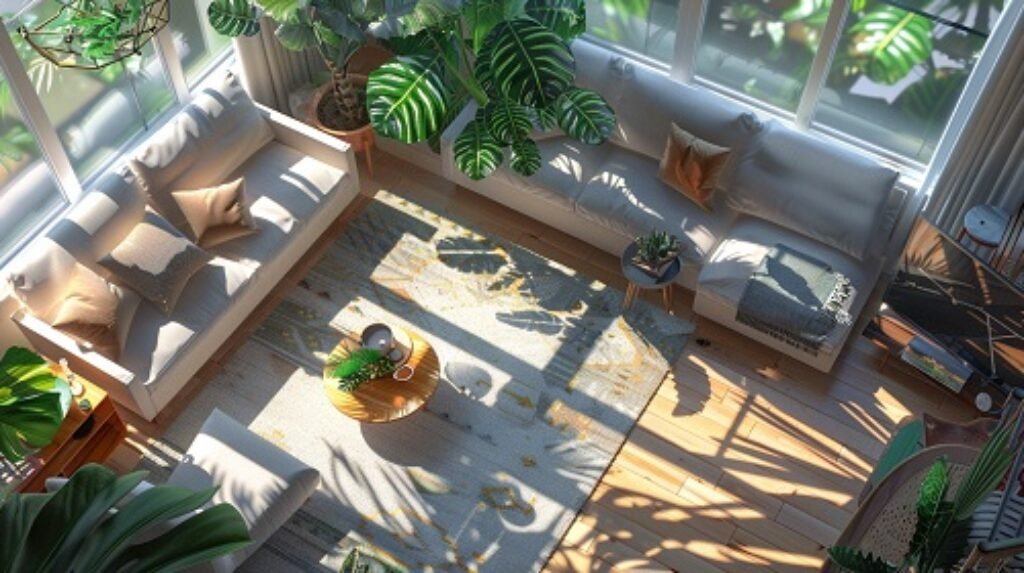Introduction:
Did you know the Rubber Plant can grow up to 10 feet tall indoors? Indoor gardening is getting more popular. Knowing the different types of indoor Houseplants helps you pick the best for your home. Whether new to plants or having lots of experience, the right plants can make your home look better and air cleaner.
From the tough Spider Plant to the exotic Clusia Princess, which can grow up to 5 meters tall, indoor plants add beauty and clean the air. Let’s explore the top 10 indoor plants that can turn any home into a green paradise.
Key Takeaways
- The Rubber Plant can grow up to 10 feet tall, making it a dramatic addition to your home.
- Spider Plants thrive in various indoor environments and are known for their resilience and adaptability.
- The Clusia Princess can reach up to 5 meters in height when not constrained by a pot.
- Snake Plants are tolerant of dry conditions and excellent for air purification, releasing oxygen at night.
- Swiss Cheese Plants flourish in reasonably bright positions out of direct sunlight, offering lush, large leaves.
1. Introduction to Indoor Houseplants
The definition of indoor houseplants is about plants that grow well in our homes. They make our spaces look better and help clean the air. These plants bring joy and health benefits like removing toxins and releasing oxygen.
Some of the most loved and popular indoor plants are the snake plant, rubber plant, and pothos. They are easy to care for and can grow in low light. This makes them great for new plant owners.
On the other hand, plants like Peace Lilies and Spider Plants are known for purifying the air. They also add beauty to our homes.
There’s a wide range of indoor plants. Some, like Fiddle Leaf Fig, need lots of sunlight. Others, like Aloe Vera, do well with little water and direct sunlight. Knowing what each plant needs helps us create a good home for them.
Each plant has its watering schedule. For example, Snake Plants need water every 2-4 weeks. Pothos, however, should be watered every 10-14 days. Humidity is also important, with most plants liking levels between 30-65%.
Creating the perfect indoor garden involves understanding sunlight and warmth needs. Plants like Christmas Cacti need specific conditions to bloom. By mimicking their natural habitats, we help them thrive.
2. Foliage Plants
Foliage plants are key to any indoor garden, loved for their leaves. They come in many colors, textures, and sizes. This makes them great for anyone who loves plants. They also help clean the air and make rooms look better.
The Snake Plant and the Pothos are great examples. The Snake Plant is easy to care for. It can grow well in low light and needs little water. It’s perfect for beginners.
The Pothos is known for cleaning the air. It can grow in different light levels. These plants show why leaves are so important.
It’s important to know what each plant needs. The Snake Plant and Pothos do well in low light. They need regular water, but not too much. Letting the soil dry out helps avoid root rot.
There are many types of foliage plants. Some have bright colors, while others like it dry. They all do well in temperatures between 50-85°F.
We deliver over 200,000 houseplants to happy customers. Our delivery rate is 95% within 1-3 days. Our customers give us 4.7 out of 5 stars for our wide selection and fast service. We offer discounts of up to 40% off, making these plants affordable.
Foliage plants are wonderful and easy to care for. They come in many colors and don’t need much light. They’re great for anyone who wants to add beauty to their home.
3. Flowering Plants
Flowering plants add color and beauty to our homes. They come in many colors and styles. This makes them perfect for any home, no matter your skill level.
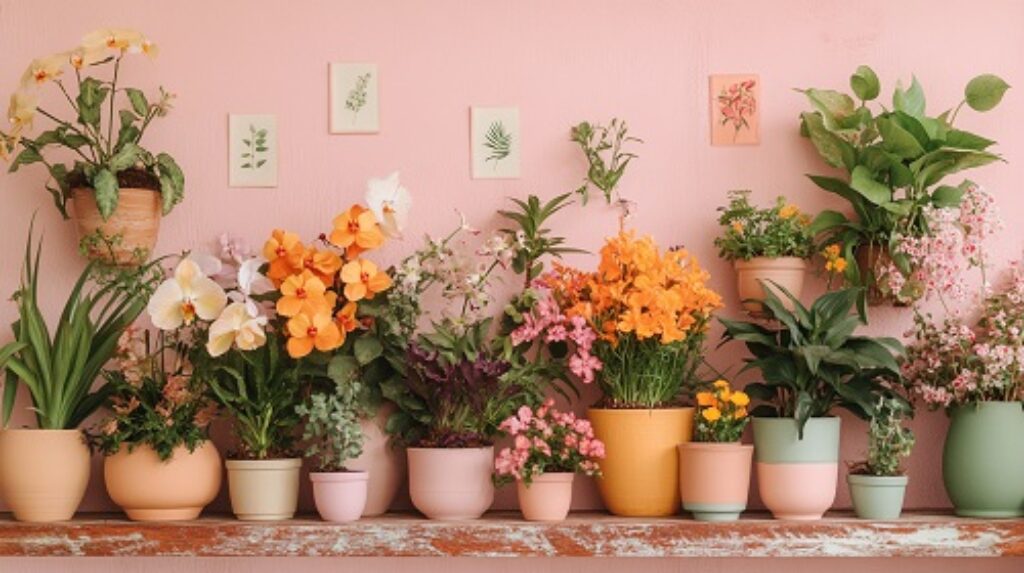
The Peace Lily is great for beginners. It has elegant white flowers and needs little sunlight and water. The African Violet blooms often and is easy to care for.
For something more unique, try the Anthurium. It has bright colors and loves warm, humid places. The Christmas Cactus blooms in the fall and winter, adding festive cheer.
To keep flowering plants happy, they need the right amount of water and light. Chrysanthemums and Cyclamen are easy to care for. They like moist soil and bright, indirect light.
The Flowering Maple and Clivia are also great choices. They have beautiful flowers and add energy to any room.
The Ixora and Crown-of-Thorns bring tropical vibes to your home. They have vibrant flowers that brighten up any space.
Choosing plants that bloom can change your home’s feel. Let’s enjoy caring for these plants and fill our homes with color and life!
4. Succulents
Succulents are now more popular than ever. They are thick, fleshy plants that store water. People love them for their looks and how easy they are to care for.
There are many types of succulents, like burro’s tail and Christmas cactus. They do well in warm, dry places. This makes them perfect for most homes.
These plants can survive in dry places because they store water. Some popular ones are Aloe Vera, Zebra Plant, and Jade Plant. They are known for their beauty and special qualities.
To care for succulents, water them well and then let the soil dry out. Use terracotta or clay pots to prevent root rot. They need at least six hours of sunlight a day, but too much can harm them.
Places like Houseplant.co.uk have a wide selection of succulents. They offer fast delivery and free shipping on some plants. They are known for their quality and have great customer service. Each plant comes with a care guide to help you keep it healthy.
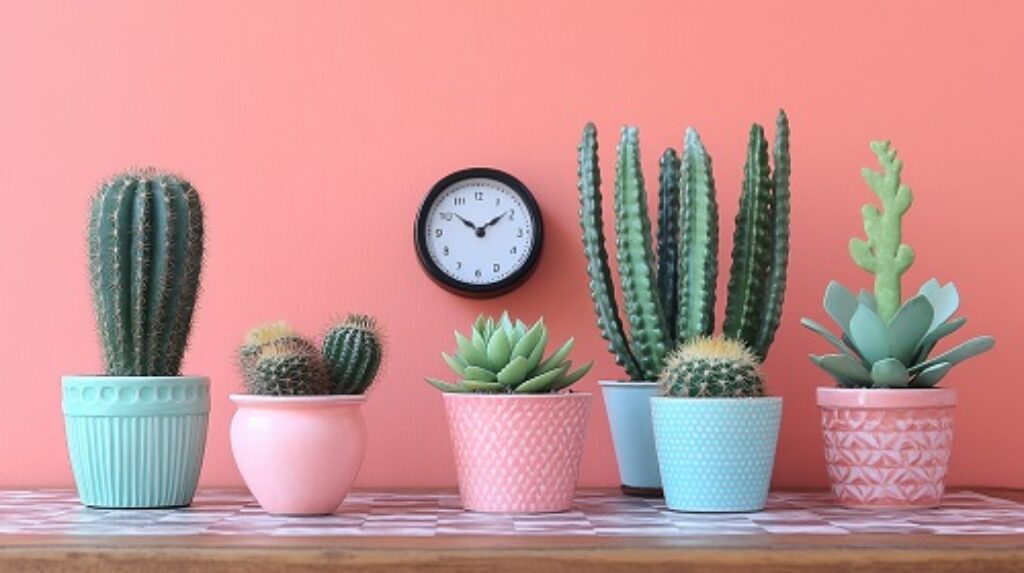
5. Cacti
Cacti are top picks for indoor gardens because they need little care and look amazing. They are a type of succulent that thrives in dry conditions. Let’s dive into what makes them special, including their looks and how to care for them.
Cacti come in many shapes and colors. The Old Lady Cactus blooms in spring with a hot pink ring. The Rainbow Hedgehog has bright pink flowers. Even the Turk’s Cap Cactus, with its hat-like shape, adds fun to any room.
It’s easy to care for cacti, making them great for beginners and experts alike. They love lots of sunlight, like the Cereus and Organ Pipe Cacti. In winter, keep them almost dry to match their natural home. Also, don’t water them too much, as they store water in their stems.
Cacti also clean the air, making homes healthier. They fit well with the trend of using plants that need little care. You can find guides for specific care, like watering and sunlight, to keep your cacti looking good all year.
Cacti come in many varieties. The Scarlet Ball has delicate spines and bright flowers. The Ric Rac Cactus blooms at night and smells great. The Christmas Cactus is safe for kids because it has no spines and blooms in color.
In summary, cacti are perfect for indoor spaces. They are easy to care for, beautiful, and come in many types. They show how nature can thrive even in tough conditions.
6. Air Plants
Air plants are truly unique indoor plants that captivate with their distinct appearance and fascinating growing habits. They absorb moisture through leaves, thriving without traditional potting methods. Originating from diverse ecosystems, air plants can be broadly classified into those from desert regions and those hailing from rainforests.
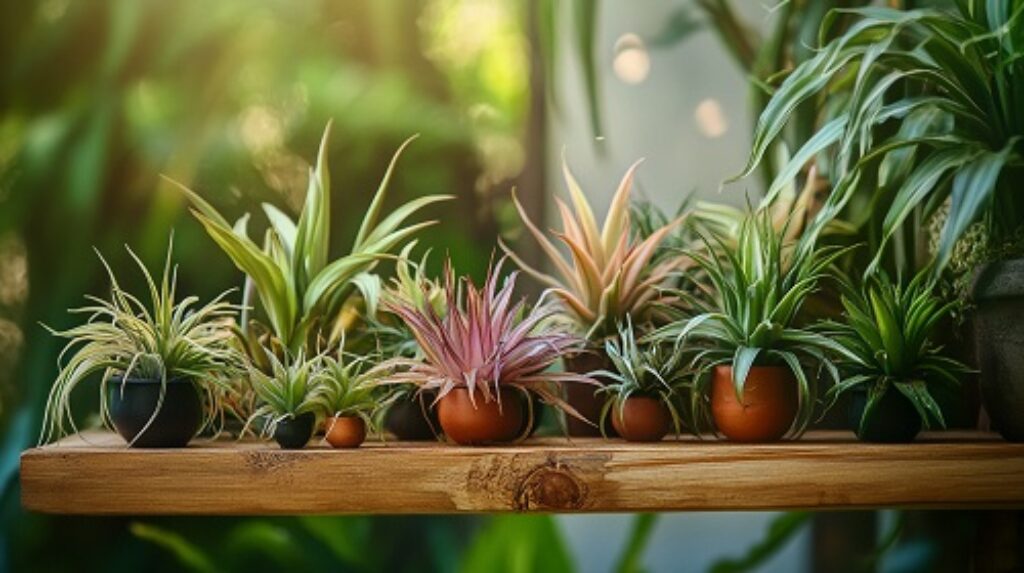
Desert species typically showcase silver or fluffy-looking trichomes, offering a unique texture. Rainforest species possess richer green foliage and fewer trichomes. Examples like Tillandsia stricta add splashes of color and visual interest with their blooms. These easy-care indoor plants are perfect for anyone looking to take their plant collection to the next level.
Taking care of air plants involves soaking them in water for a few minutes once a week. Ensuring they dry out completely afterward is key. This simple routine helps them absorb the necessary moisture through their leaves. Positioning air plants correctly also contributes to their health; green-leaved varieties excel in low-light conditions, whereas sunnier spots may benefit from species like Tillandsia xerographica. A crucial tip is to avoid placing them near south-facing windows during the summer to prevent scorching.
Air plants produce “pups” or baby plants around the mother plant after flowering. This process ensures a dynamic and ever-evolving display. Making them a wonderful addition to any home.
Our customers have purchased over 200,000 houseplants, with an impressive 95% of orders delivered within 1-3 working days. If you’re intrigued by soil-less plants that absorb moisture through leaves, now is a great time to explore air plants. With up to 45% off selected indoor plants and 38% off rare plant varieties, these unique indoor plants can genuinely enhance your living spaces. Rated 4.7/5 as “EXCELLENT” in customer reviews, they are pet-friendly and low-maintenance.
7. Ferns
Ferns are known for their lush, feathery leaves and ability to thrive in many environments. They are a favorite among indoor plant lovers. These plants are valued for their greenery and air-purifying qualities, making them great for homes and offices.
The Boston Fern and Maidenhair Fern are popular fern types. The Boston Fern grows quickly and needs to be divided yearly. The Maidenhair Fern prefers bright, filtered light and high humidity, making it perfect for indoor spaces.
The Rabbit’s Foot Fern and Staghorn Fern have unique features. The Rabbit’s Foot Fern is loved for its distinctive look. The Staghorn Fern produces “pups” that can be rooted in moss. The Kangaroo Fern spreads by furry rhizomes and thrives in bright, north-facing windows. The Tricolor Fern comes in various colors, from bronze-red to silvery white.
For those new to fern care, remember they prefer indirect light and high humidity. Bathrooms and kitchens are great places for ferns because they are naturally moist. Make sure the soil is consistently moist but avoid overwatering, as it can cause leaves to droop and turn yellow.
Houseplant.co.uk is a reliable source for ferns, offering a variety of options. They often have discounts of up to 30% off and have a customer satisfaction rating of 4.7 out of 5. They have delivered over 150,000 plants and provide detailed care instructions to help your ferns thrive.
Adding ferns to your home brings vibrant green foliage and connects you with a plant from over 350 million years ago. Ferns’ timeless beauty and air-purifying qualities make them a lasting addition to any indoor garden.
8. Trailing and Climbing Houseplants
Adding trailing and climbing plants to our indoor space can change everything. These decorative houseplants are not just pretty; they also clean the air. We’ve delivered over 200,000 plants to happy customers, making sure each one is well cared for on its way to you.
These plants grow up and down, perfect for hanging baskets or climbing frames. Favorites like Monstera and Pothos do well in indirect light. Remember to water them right, based on the humidity and temperature around them, so they stay green and vibrant.
Houseplant.co.uk is known for its quality and service, with a 4.7 out of 5 rating. We provide detailed care guides with every plant, helping beginners. For instance, the heartleaf philodendron is super easy to care for. Plus, English Ivy and Monstera fit any style you like.
Right now, you can save up to 44% on trailing plants and up to 50% on climbing ones. We offer fast delivery, with 95% of orders arriving in 1-3 days. These indoor climbing plants add a natural touch and make your home healthier.
9. Large Indoor Houseplants
Large indoor plants are truly majestic, offering a grand presence. They can transform any living space. They are tall plants that serve as focal points, bringing tranquility and natural beauty into our homes.
Popular choices include the Monstera deliciosa, the Fiddle Leaf Fig (Ficus lyrata), the Rubber Plant (Ficus elastica), and the Bird of Paradise (Strelitzia reginae).
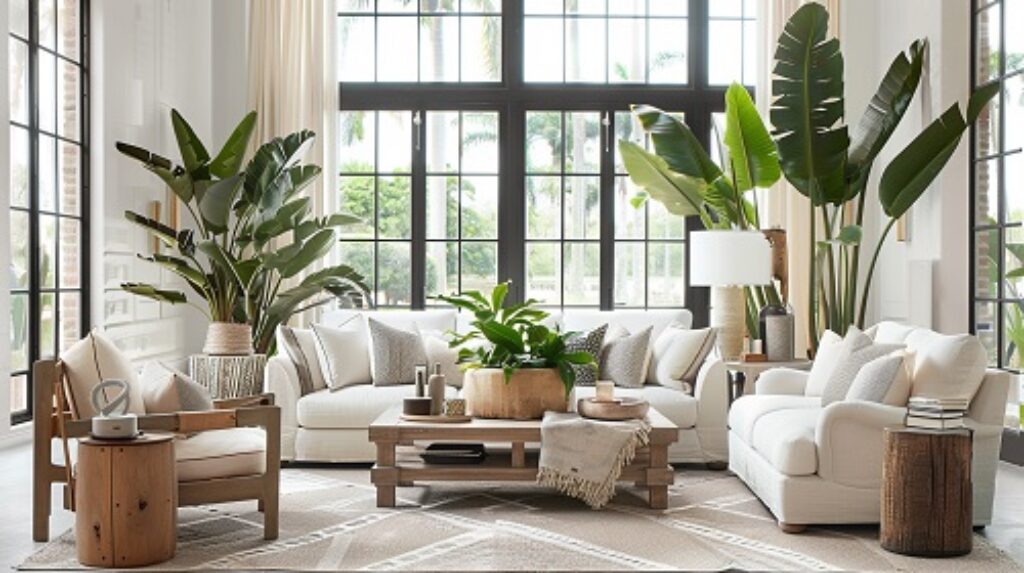
By integrating these plants into our homes, we elevate our interior decor. They also improve air quality, as they are excellent air purifiers. With over 131 products listed online, plant lovers have access to a diverse selection.
Care Tips for Houseplants:
Proper care is essential for these majestic houseplants. Ensure they receive plenty of indirect sunlight to avoid leaf scorch. Watering should be balanced – only water when the top inch or two of soil feels dry.
Use a balanced, water-soluble fertilizer every few months to maintain their vigor. Prune during the active growth phase, typically in spring or summer, to control height and shape. Use clean, sharp tools to avoid harming the plant.
Additionally, keep the leaves clean with regular dusting and occasional cleaning. This helps them photosynthesize efficiently. Free delivery is available for certain products, and with a 95% success rate in delivering plants swiftly and securely, ordering online is a convenient option.
For those seeking unique and transformative decor solutions, these tall plants are an excellent choice. Let’s embrace the natural elegance and numerous benefits that large indoor plants bring into our living spaces.
10. Unusual or Exotic Plants
Among the many houseplants, some stand out. Exotic houseplants add a unique touch to any room. They spark interesting conversations. For example, the Venus Flytrap is famous for catching mosquitoes.
Orchids, with over 30,000 species, are loved for their exotic flowers. They need special care to grow well. The Alocasia, or arrowroot, is another rare but easy-to-care-for plant.
For a tropical feel, consider the Coconut Palm or the Footstool Palm. They need lots of light and warmth. These plants add an exotic feel to your home.
The Pineapple plant is great if you want something edible and decorative. The Baobab can grow up to 1.5 meters tall. It’s a striking centerpiece.
For climbing plants, try the String of Hearts or Porcelain Flowers. They add height and beauty. Tillandsias, or air plants, don’t need soil. They’re perfect for hanging decorations.
UK plant lovers have given these plants high marks. They rate them 4.7/5 on Houseplant.co.uk. With fast delivery and free shipping, getting these plants is easy. Happy customers enjoy these unique plants in their homes.
11. Choosing the Right Houseplants
Choosing the right plant for your home can be fun but also tricky. There are many factors to consider to ensure your plants grow well. Light levels are key and change a lot depending on the room and window.
For example, north-facing windows can be tough in winter because of less light. But, too much direct sun can burn the leaves.
Humidity is also important. Bathrooms and kitchens are usually more humid, perfect for plants like orchids. But, living rooms might need misting or a humidifier for these plants.
Seasonal temperature changes can also affect plants. Hot spots, direct sunlight, or cold drafts can harm them.
Think about the size of the plant when choosing. Small plants fit well on windowsills or shelves. But, bigger plants are better for seating areas and entrances.
It’s also important to consider how much a plant will grow and how easy it is to move. This ensures it fits well in your home.
Each plant needs different amounts of light. Some plants need lots of sunlight, while others prefer partial shade. For darker spots, choose plants that can handle less light.
Using artificial grow lamps can help provide enough light, especially in rooms with not enough natural light.
Don’t forget about watering and avoid overwatering. Plants like Parlor Palms and Aloe Vera need specific watering. Self-watering planters can help keep the soil moist.
Fertilizing is also important. It gives plants the nutrients they need, which might not be in the soil.
Keeping the right temperature is crucial for indoor plants. Heating and cooling systems can change how fast the soil dries out. Adjust how often you water as the seasons change to keep your plants happy.
12. Conclusion
Exploring indoor house plants shows how they can make our homes look better and feel healthier. Plants like the Philodendron can grow up to 10 feet tall. Meanwhile, Snake Plants are small but great at cleaning the air.
ZZ plants can grow up to 5 feet and are very hardy. Flowering plants, like the Peace Lily, are popular for their beauty. Trailing plants, like Pothos, can make our spaces look lush and green.
Succulents and cacti need little care, making them ideal for busy people. But, plants like Gardenia require more attention. Whether you like simple succulents or complex ferns, each plant adds something special to our homes.
We can turn our homes into mini gardens, creating a peaceful and productive space. By picking and arranging the right plants, our homes can show off our personalities. This makes our living spaces healthier and more enjoyable.
FAQ
What are the best types of indoor houseplants for home aesthetics?
The Fiddle Leaf Fig, Rubber Plant, Snake Plant, Peace Lily, and Monstera are top picks. They look great and are easy to care for. This makes them perfect for boosting your home’s look.
Which indoor houseplants are best for beginners?
Beginners should start with the Snake Plant, Spider Plant, Pothos, and ZZ Plant. They need little care and are great for new gardeners.
What are some low-light indoor plants?
Plants that do well in low light are the Snake Plant, ZZ Plant, Pothos, and Peace Lily. They add greenery and clean the air, even in dim spaces.
Are there indoor plants that purify the air?
Yes, plants like the Spider Plant, Peace Lily, Aloe Vera, and Boston Fern purify the air. They help make your home air cleaner.
Which are some pet-friendly indoor houseplants?
Safe plants for pets include the Spider Plant, Areca Palm, Boston Fern, and Peperomia. They won’t harm your pets, keeping your home safe.
How do I care for easy indoor plants like succulents?
Succulents need bright light and should be watered only when the soil is dry. They’re easy to care for, making them great for busy people.
What are some indoor plants that also flower?
Plants that flower include the Peace Lily, African Violet, Orchids, and Anthurium. They add color and beauty to your home.
How can I choose the right indoor plants for my home?
Consider light, humidity, and care needs when picking plants. Choose ones that fit your home and your care abilities for success.
What are air plants, and how should I care for them?
Air plants don’t need soil. They get water and nutrients through their leaves. Weekly soaking and drying are key. They look cool in glass globes or on wood.
Are there indoor plants suitable for low-maintenance care?
Yes, plants like the Snake Plant, ZZ Plant, Pothos, and Cast Iron Plant need little care. They’re perfect for busy people.
What are some large indoor houseplants that make great focal points?
Big plants like the Fiddle Leaf Fig, Rubber Plant, and Bird of Paradise are great for large rooms. They add size and style.
What care tips should I follow for keeping my houseplants healthy?
Know your plant’s light and water needs. Use good soil and ensure drainage. Check for pests and prune regularly. Adjust care for your plant’s needs.
Source Links
- https://bloomboxclub.com/blogs/news/10-amazing-indoor-house-plants-for-sunny-windows – 10 Amazing Indoor House Plants For Sunny Windows
- https://www.gardenhealth.com/advice/houseplant-care/our-top-10-most-popular-house-plants – Our Top 10 Most Popular House Plants – Indoor – Westland Garden Health
- https://www.gardendesign.com/houseplants/best-indoor.html – 24 Best Indoor Plants – Find Your Perfect Houseplant – Garden Design
- https://homesteadbrooklyn.com/all/2017/1/21/growing-plants-indoors-a-beginners-guide – Growing plants indoors: A beginner’s guide — HOMESTEAD BROOKLYN
- https://www.mybreezyroom.com/houseplants/ – Houseplants for Beginners: How to Keep House Plants Alive
- https://gardenerspath.com/how-to/indoor-gardening/houseplant-care-primer/ – Guide to Basic Care of Houseplants | Gardener’s Path

